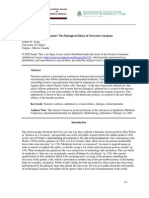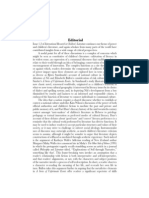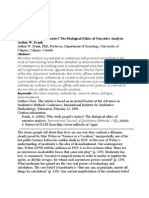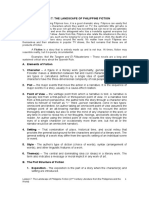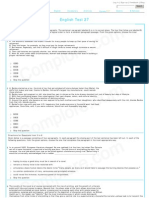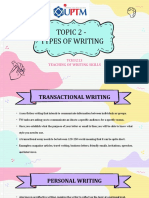0 ratings0% found this document useful (0 votes)
48 views21st Lit Genre Handout
21st Lit Genre Handout
Uploaded by
Jon Michael BoboyoThis document discusses several 21st century literary genres including chick lit, hyper-poetry, spoken poetry, and blogs. Chick lit focuses on stories of modern independent women dealing with relationships, careers, and identity. Hyper-poetry utilizes computers and hyperlinks to create interconnected poetry. Spoken poetry is a performance art that emphasizes word play through vocal delivery. Blogs are regularly updated online journals that can be personal reflections or address public issues through various stylistic approaches.
Copyright:
© All Rights Reserved
Available Formats
Download as DOCX, PDF, TXT or read online from Scribd
21st Lit Genre Handout
21st Lit Genre Handout
Uploaded by
Jon Michael Boboyo0 ratings0% found this document useful (0 votes)
48 views4 pagesThis document discusses several 21st century literary genres including chick lit, hyper-poetry, spoken poetry, and blogs. Chick lit focuses on stories of modern independent women dealing with relationships, careers, and identity. Hyper-poetry utilizes computers and hyperlinks to create interconnected poetry. Spoken poetry is a performance art that emphasizes word play through vocal delivery. Blogs are regularly updated online journals that can be personal reflections or address public issues through various stylistic approaches.
Original Title
21st-lit-genre-handout
Copyright
© © All Rights Reserved
Available Formats
DOCX, PDF, TXT or read online from Scribd
Share this document
Did you find this document useful?
Is this content inappropriate?
This document discusses several 21st century literary genres including chick lit, hyper-poetry, spoken poetry, and blogs. Chick lit focuses on stories of modern independent women dealing with relationships, careers, and identity. Hyper-poetry utilizes computers and hyperlinks to create interconnected poetry. Spoken poetry is a performance art that emphasizes word play through vocal delivery. Blogs are regularly updated online journals that can be personal reflections or address public issues through various stylistic approaches.
Copyright:
© All Rights Reserved
Available Formats
Download as DOCX, PDF, TXT or read online from Scribd
Download as docx, pdf, or txt
0 ratings0% found this document useful (0 votes)
48 views4 pages21st Lit Genre Handout
21st Lit Genre Handout
Uploaded by
Jon Michael BoboyoThis document discusses several 21st century literary genres including chick lit, hyper-poetry, spoken poetry, and blogs. Chick lit focuses on stories of modern independent women dealing with relationships, careers, and identity. Hyper-poetry utilizes computers and hyperlinks to create interconnected poetry. Spoken poetry is a performance art that emphasizes word play through vocal delivery. Blogs are regularly updated online journals that can be personal reflections or address public issues through various stylistic approaches.
Copyright:
© All Rights Reserved
Available Formats
Download as DOCX, PDF, TXT or read online from Scribd
Download as docx, pdf, or txt
You are on page 1of 4
Gallery Walk Strategy revitalize, that rekindle the desire to build an identity not out of pain but
out of possibilities, which are forward-looking and optimistic and
21st Century Literary Genres
fruitful.
1. Chick lit - Written by women, uses strong female character who is trying to j. The stories need not always be about what men, society, religion and
live in the modern world. traditions did to erase the female consciousness, rather they should
a. To transform the world, we do not have to raise slogans and conspire to emphasize how female consciousness can be reconstructed and
usher in revolutions but have to simply change the narrative. rejuvenated. Chick lit can be considered one such step which helps in
b. Light, amusing stories about the type of issues an average female deals the process of constructive identity formation in readers by presenting
with: romance, career, family, friends, etc. The key element is the them a worldview that is inspiring and accommodating.
humorous way the protagonist deals with whatever the plot brings her k. Chick lit provides a renewed idea of home for young, educated, middle-
way. class working women. The heroines of chick lit take pride in owning
c. Chick lit in the genre of fiction is also such an attempt which endeavors their homes, however small. It is a site of comfort, creativity, bonhomie
to replace the images of victim feminism with a more empowering and and romance. They live alone away from parental control and therefore
constructive portrayal of women. are more independent and self-aware as was perhaps desired by Virginia
d. It is to present an alternate image of women— rejoicing, winning, and Woolf.
achieving; now that times have changed, and women are born into a l. Living alone in a room of one’s own is an important factor in the
world full of opportunities which were earlier denied to them. individualization process because the solitude provides a person the
e. The general themes of chick lit deal with the dilemmas in the life of opportunity to discover him/herself, away from the intrusiveness of the
women regarding marriage, love, work, family, and a search for outside world as well as of the family.
identity—issues which a modern working woman has to face on a day- m. The room becomes an extension of one’s personality. Chick lit often
to-day basis. contains long descriptions of the house/home of the protagonist.
f. The heroines of these books are generally women in the age group of n. A car is not only a symbol of social status but is also a means of
25–40 years, successful at work and financially independent, trying unfettered mobility.
to pursue the ultimate quest of womanly life—a search for true love. o. In chick lit, the car becomes a symbol of independence for women who
g. In most of the novels we find the protagonists caught in a web of social can travel anywhere they want without seeking permission or help from
and religious practices and conventions and psychological inhibitions anyone.
that effectively obstruct the process of modernization and emancipation. p.
Consequently, the existing gendered balance of power is perpetuated. 2. Hyper – poetry - It is also called cyber poetry. It could not be presented
h. The images used in these books are images of violence, pain, without the aid computers and the internet and include verse with links to sub
loneliness, and anxiety. Zoological imagery of predator and prey is poems or footnotes, poetry “generation”, or poetry with movements or images.
repeatedly found in these works to represent the victimization of a. It is concluded that hypertext began as a term for forms of hypermedia
women. Images of death and disease also haunt the pages of these (human-authored media that “branch or perform on request”) that
novels. Tired of the roles that these women are forced to enact, they operate textually.
look upon solitude not as punitive but as a form of reprieve, reprieve b. “In hypertext… the reader determines the unfolding of the text by
from the incessant demands of husband, children, and household duties. clicking on certain areas, the so-called hyperlinks, that bring to the
i. Women of the 21st century, descendants of all these lost women, now screen other segments of text.”
need to step out of the psychological framework of victimization and c. “hypertext” the term was coined by Theodor Holm (“Ted”)
take control of their lives. They require stories that regenerate and
d. ‘hypertext’ to mean a body of written or pictorial material c. A variety of blogging services such as Blogger, Wordpress, and
interconnected in such a complex way that it could not conveniently be LiveJourna make it possible for anyone to run a blog without the need
presented or represented on paper.” for a personal website.
e. “Hypertext is a term coined by Ted Nelson for forms of hypermedia d. Technorati’s 2009 State of the Blogosphere report (McLean 2009)
(human-authored media that branch or perform on request) that operate found tha the majority of the 2,828 U.S. bloggers surveyed were male,
textually. Examples include the link-based ‘discrete hypertext’ (of between 18 and 44 years old, and had a relatively high level of income
which the Web is one example) and the level-of-detail-based and educational qualifications.
‘stretchtext.’” i. “personal satisfaction” (76 % of the respondents)
f. Nelson then presents examples of types of hyper-media that could be ii. Personal musings (reflection)” (53 %).
made available to students. The first of these is under the heading e. Stylistically, blogs are a highly variable form of self-expression.
“Discrete Hypertexts.” Nelson writes: “‘Hypertext’ means forms of i. a blog entry can be speech-like or written-like, colloquial or
writing which branch or perform on request; they are best presented formal, and can relate private or public (in the sense of
on computer display screens... Discrete, or chunk style, hypertexts addressing established topical areas of the mainstream media,
consist of separate pieces of text connected by links.” This is the first such as politics sports, entertainment, or technology) issues.
appearance of the term “link” in the essay. ii. It can target a wide audience or a small, select readership and be
g. “Stretchtext as a form of hypertext is easy to use without getting lost… written for personal or professional reasons.
There are screen and two throttles. The first throttle moves the text f. According to Winer (2001), blog posts canonically encode the
forward and backward, up and down on the screen. The second throttle following information:
causes changes in the writing itself: throttling toward you causes the i. Title
text to become longer by minute degrees.” Note that Nelson referred to ii. Text
hypertext as “forms of writing which branch or perform on request.” iii. Tags/Categories
Discrete hypertext uses links to branch on request. Stretchtext uses no iv. Author
links — instead making a nonbranching v. Time of publication
h. performance. vi. URL
3. Spoken Poetry - Is a poetic performance art that is word – based. It is an oral g. Types of blogs (Herring, 2005)
art that focuses on the aesthetics of word play such as intonation and voice i. diaries/personal journals, which record the personal
inflection. experiences and thoughts of the blogger from a subjective
4. Blogs - It is a shortened of the term “web blog”, a regularly updated journal on viewpoint;
the internet. ii. filters, which filter, quote, link, and/or comment on information
a. the earliest practitioner definitions of what constituted a blog were from other sources;
based on the presence of dated entries containing links, commentary, iii. k-logs, which store, tag, and/or classify information from other
and thoughts on a personal website. sources on a single topic;
b. A variety of media contents (photos, music, video clips, etc.) can easily iv. mixed, which combine at least two of the primary three types; or
be embedded in blog entries or other hypertext-based services, while at v. other, which cannot be associated with any of the primary types.
the same time portals and multimedia applications integrate blog-like h. careful language analysis when approaching blogs
functions. What remains unchanged is that blogs structure digital i. speaking in one’s own personal voice and being open for
content sequentially and that they are more frequently maintained by dialogue rather than engaging in one-way-communication are
individuals than institutions or companies core elements readers have come to expect from blog
communication, be it in private online journals, corporate blogs, 10. Alternate history fiction: stories that focus on true historical events
or political blogs. but are written as if they unfolded with different outcomes.
5. Speculative fiction - the setting is futuristic and involves supernatural 11. Superhero fiction: stories about superheroes and how they use their
elements. It encompasses horror and science fiction works. The term abilities to fight supervillains.
“speculative fiction” was used for the first time by Robert Heinlein in 1947. 6. Textula - Has its origin in “Tanaga”. The term "textula" is a blend of the
The terms was largely associated with only the science fiction genre in the late English word "text" and the Filipino word "tula!' Meaning text poem, it is a
twentieth century, as science fiction is a widely-read genre that contains poem written in the form of a text message. Usually consisting of one or two
speculative elements. The term expanded in the twenty-first century to stanzas, it is sent as a direct communication to a person close to the sender.
encompass more subgenres beyond just science fiction, like fantasy and a. A poetry mastered by Frank Rivera using 7 syllables
dystopian literature. Today, speculative fiction is a blanket term for the stories b. Basic Ryme Schemes
that take place beyond our known world. i. Basic or AAA
a. Science fiction: stories with imagined technologies that don’t exist in ii. Enclosed ABBA (inipit)
the real world, like time travel, aliens, and robots. iii. Alternate ABAB (salitan)
b. Sci-fi fantasy fiction: sci-fi stories inspired by mythology, folklore, and iv. AABB (sunuran)
fairy tales that combine imagined technologies with elements of magical c. It can be expressed as a tanaga, dalit, and diona
realism. i. Tanaga- 7 syllables with 4 lines
c. Supernatural fiction: sci-fi stories about secret knowledge or hidden ii. Dalit- octosyllabic with 4 lines
abilities including witchcraft, spiritualism, and psychic abilities. iii. Diona- 7 syllables with 3 lines
d. Space opera fiction: a play on the term “soap opera,” sci-fi stories that 7. Flash fiction - It is micro – fiction, micro – narrative and sudden fiction.
take place in outer space and center around conflict, romance, and a. Flash fiction writers deliberately sketch scenes with strokes of
adventure. ambiguity to keep readers fully attuned to each word.
e. Urban fantasy fiction: fantasy stories that take place in an urban b. They also withhold details regarding the story’s characters, events,
setting in the real world but operate under magical rules. scenes, and atmosphere that watchful readers try to compensate within
f. Utopian fiction: stories about civilizations the authors deem to be active imagination.
perfect, ideal societies. c. The term “Flash Fiction”was coined by James Thomas, in 1992, to
g. Dystopian fiction: stories about societies deemed problematic within include stories of up to 750 words count (Thomas & Shapard, 2006).
the world of the novel, often satirizing government rules, poverty, and d. Favorite topics, in flash fiction, include gender, social class,
oppression. relationships, suicide, death, isolation, racism, sex, dystopia,
h. Apocalyptic fiction: stories that take place before and during a huge technology, interpersonal disputes, and easily recognizable
disaster that wipes out a significant portion of the world’s population. circumstances, surreal situations, global problems, etc. (Batchelor,
The stories center around characters doing everything they can to stay 2012
alive—for example, running from zombies or trying to avoid a deadly 8. Grapic Novel - Utilizes pictures in narrating a long story; it has growing
plague. popularity.
i. Post-apocalyptic fiction: stories that take place after an apocalyptic a. Graphic novel can be defined as an imaginary narrative that is as long
event and focus on the survivors figuring out how to navigate their new as a novel and uses comics as the type of presentation. This term was
circumstances—for example, emerging after a global nuclear holocaust coined by Will Eisner, who is one of the most important comics artists
or surviving a total breakdown of society. of the USA.
b. is a form of narration which is composed of pictures and writing in a
supplemental manner to tell a story or an event
c. “a specific form of literature, a form of art, which is close to
painting, and also a kind of movie, which is motionless and Electronic Literature (refers to works commonly published and shared on the Web.
captured in panels.” Unlike traditional printed literature, it has features that could only be presented through
d. The primary structural factors that compose graphic novel are panels, multimedia)
captions, and speech balloons.
e. In order to stress the mood of the story told, the arrangement of the 1. Hyperpoetry
panels is used as part of the creative process a. This is a kind of graphic poetry which combines words with images. It
f. Captions and speech balloons, on the other hand, comprise the written has no standard lines or verses, but its words are arranged in a way that
part of the graphic novel. it creates meaning and visual effect.
g. Captions are the boxes with some explanatory information about the 2. Hyperfiction
action shown by means of pictures. They stand for the narrator of the a. This contains hyperlinks. When readers click on a hyperlink, they go to
story; give additional information with a third person perspective another Web page that contains the next part of a story.
h. Speech balloons can be in different shapes in order to represent 3. Photo poem
sound or emotion. Macková lists those types as “ordinary a. This uses real-life images or electronically generated images as
balloon”,“whispering balloon”, “burst balloon”, “radio/electric representation of the textual poem.
balloon”, “emanating speech balloon”,“wavy balloon”, “thought 4. Silent comics
balloon”, and “telepathic balloon” a. These have no verbal dialogues. The dialogues are presented through
i. “it is left to the reader to fill the‘gaps’, or absences of connections, symbols
between the frames in order to make sense of the text.” 5. Textula
j. By means of facial expressions, gestures and colours, images can show a. This poem is intended to be shared through the SMS.
the characters’emotions; therefore, weight is in the images and text 6. Blog
does less work. a. This Web site is where a person writes about his or her personal
k. We see that capital letters, lowercases, bolding or italicizing words, and opinions, activities, and experiences.
typography are all used for some purpose in graphic novels.
l. “an asterisk, a breath mark, a foreign language sign, a musical note sign,
a lowercase and special characters such as &#@.”
m. Structuralism
i. First type is the sign in the form of symbols such as language,
punctuation marks or numbers,
ii. Second type is imagery-based signs (icons).
You might also like
- The Four WindsDocument1 pageThe Four WindsSachin 2003No ratings yet
- O'Donovan MAThesisDocument146 pagesO'Donovan MAThesisSaad MilanNo ratings yet
- Editable WORD We Ate The Children LastDocument10 pagesEditable WORD We Ate The Children LastjjandasekNo ratings yet
- Pre-Raphaelite Poetry: Dante Gabriel Rossetti Turned To Poetry From Painting. He Was GreatlyDocument2 pagesPre-Raphaelite Poetry: Dante Gabriel Rossetti Turned To Poetry From Painting. He Was GreatlypoojaNo ratings yet
- Loxley - Type - The Secret History of LettersDocument257 pagesLoxley - Type - The Secret History of LettersMathan WeinbergNo ratings yet
- 21 Century Literature From The Philippines and The World: II.: Concept Notes With Formative ActivitiesDocument19 pages21 Century Literature From The Philippines and The World: II.: Concept Notes With Formative ActivitiesRomalyn Joy Baldo Viernes100% (2)
- Defining 21 Century Literature: Prepared By: Lovely Joy O. Ruiz Literature InstructorDocument5 pagesDefining 21 Century Literature: Prepared By: Lovely Joy O. Ruiz Literature InstructorMary Joyce Lacambra AquinoNo ratings yet
- 21st Century LiteratureDocument3 pages21st Century LiteraturehmoracoyNo ratings yet
- Dolls, Female Identity and The Material Imagination (PDFDrive)Document255 pagesDolls, Female Identity and The Material Imagination (PDFDrive)Carolina BertaNo ratings yet
- 21st Century LiteratureDocument10 pages21st Century LiteratureIan Dave Espares OpaoNo ratings yet
- Bell Hooks ThesisDocument4 pagesBell Hooks Thesisfjcsyx0f100% (2)
- Best Essay WrittenDocument6 pagesBest Essay Writtenb72hvt2d100% (3)
- Women and Bodily Separation in Literature From The Victorian EraDocument76 pagesWomen and Bodily Separation in Literature From The Victorian EraFira MaurinaNo ratings yet
- Why Study People's Stories? The Dialogical Ethics of Narrative AnalysisDocument9 pagesWhy Study People's Stories? The Dialogical Ethics of Narrative AnalysisKurt BorgNo ratings yet
- Module 3. Lit. Themes in World LiteratureDocument10 pagesModule 3. Lit. Themes in World LiteratureMartin John PunzalNo ratings yet
- Engl Ed 112Document9 pagesEngl Ed 112Jenny May Jose TumabangNo ratings yet
- Ib Learner ProfileDocument2 pagesIb Learner ProfilelauralbieriNo ratings yet
- Lesson 1Document8 pagesLesson 1Aura lee JoyaNo ratings yet
- KWB118 Week 2 Genre and IdeologyDocument37 pagesKWB118 Week 2 Genre and IdeologyDan AmosNo ratings yet
- Learning Activity Sheet in 21 Century Literature From The Philippines and The WorldDocument6 pagesLearning Activity Sheet in 21 Century Literature From The Philippines and The WorldLILIAN ROSE DE LARANo ratings yet
- Editorial: Adventures of Nils and Elizabeth Bullen's Consideration of Risk Culture in LemonyDocument3 pagesEditorial: Adventures of Nils and Elizabeth Bullen's Consideration of Risk Culture in LemonyKareena NarwaniNo ratings yet
- 21st Module (Summarized) - 1st QuarterDocument11 pages21st Module (Summarized) - 1st QuarterpanaliganmjlordNo ratings yet
- Why Read People Stories - ShankarDocument12 pagesWhy Read People Stories - Shankarrads_mathurNo ratings yet
- Literary CriticismDocument8 pagesLiterary CriticismJames DavidNo ratings yet
- Elt 314 Reviewer 3rd ExamDocument20 pagesElt 314 Reviewer 3rd ExamRoland-Jay EfhanNo ratings yet
- Afl2603 ExamDocument6 pagesAfl2603 ExamtshekanembovaneNo ratings yet
- Sir Adalid ReviewerDocument4 pagesSir Adalid ReviewerBalonio DexcieNo ratings yet
- Lesson 7 The Landscape of Philippine FictionDocument5 pagesLesson 7 The Landscape of Philippine FictionAvril RamosNo ratings yet
- The Method in The Madwoman Functions of Female Madness and Feminized Liminality in Jane Eyre, Wuthering Heights, and The Yellow WallpaperDocument112 pagesThe Method in The Madwoman Functions of Female Madness and Feminized Liminality in Jane Eyre, Wuthering Heights, and The Yellow WallpaperivycpoitrasNo ratings yet
- The Theory of Literature OrgDocument244 pagesThe Theory of Literature Orghusseinsalma470No ratings yet
- Pop Culture Midterm 2Document4 pagesPop Culture Midterm 2Kaye PalerNo ratings yet
- 21st Teachers NoteDocument3 pages21st Teachers NoteBeyoung GamefightNo ratings yet
- Emerging Literature Is A Threat To Classic Literature.Document3 pagesEmerging Literature Is A Threat To Classic Literature.Geneva TabiosNo ratings yet
- Lesson 6 Critic PaperDocument5 pagesLesson 6 Critic PaperJINKY AMORNo ratings yet
- importannce of literatureDocument2 pagesimportannce of literaturejeetshetty6No ratings yet
- Grade 7 Curriculum Map 2020 - 2021: Essential Questions/Essential UnderstandingsDocument5 pagesGrade 7 Curriculum Map 2020 - 2021: Essential Questions/Essential UnderstandingsKen De VeraNo ratings yet
- Granita Jazmie Ciren M.Document3 pagesGranita Jazmie Ciren M.Pagas, Princess Jewell A.No ratings yet
- CAT 2009 English Test 27Document3 pagesCAT 2009 English Test 27comploreNo ratings yet
- Zuasola, Iriz G. Beed-Gen - Ed. Iii AS15-Eng 2: The Importance of Children's LiteratureDocument4 pagesZuasola, Iriz G. Beed-Gen - Ed. Iii AS15-Eng 2: The Importance of Children's LiteratureIriz Gonzaga ZuasolaNo ratings yet
- Lesson 1 PPT W1-W2Document32 pagesLesson 1 PPT W1-W2Lily Mae De ChavezNo ratings yet
- Placing The SelfDocument10 pagesPlacing The SelfIsabel GaviriaNo ratings yet
- 21st Century Literature Week 6 10Document12 pages21st Century Literature Week 6 10che villNo ratings yet
- 2nd Quarter Handout IntroDocument10 pages2nd Quarter Handout IntroXianPaulette Mingi ManalaysayNo ratings yet
- The Burdens of Perfection: On Ethics and Reading in Nineteenth-Century British LiteratureFrom EverandThe Burdens of Perfection: On Ethics and Reading in Nineteenth-Century British LiteratureNo ratings yet
- Stranger Than Fiction: Urban Myths: About The AuthorsDocument3 pagesStranger Than Fiction: Urban Myths: About The AuthorsOlivia MontoyaNo ratings yet
- Creative Writing GlossaryDocument5 pagesCreative Writing GlossaryRća RzNo ratings yet
- Creative Writing GlossaryDocument5 pagesCreative Writing GlossaryRća RzNo ratings yet
- 21st q1 LP 4 Las 2ndqrtrDocument5 pages21st q1 LP 4 Las 2ndqrtrKristel CabatoNo ratings yet
- Group 3 ENG 22Document49 pagesGroup 3 ENG 22Guevarra Thricia Jusenia BalbuenaNo ratings yet
- The World, The Text, and The Critic Is A Great Work ofDocument35 pagesThe World, The Text, and The Critic Is A Great Work ofjalalNo ratings yet
- Introduction To Literary TheoryDocument21 pagesIntroduction To Literary Theoryapi-2164592040% (1)
- QuestionsDocument9 pagesQuestionssikhamura22No ratings yet
- When We Dead AwakenDocument6 pagesWhen We Dead AwakenForhad RaselNo ratings yet
- Atwood NotesDocument2 pagesAtwood NotesDesmond MartiniqueNo ratings yet
- All About English Literature and Julius CaesarDocument30 pagesAll About English Literature and Julius Caesarpriyankathombare2005No ratings yet
- Mabuhay! Are You Ready?Document20 pagesMabuhay! Are You Ready?Tired LupinNo ratings yet
- Reading Materials Grade 7-10 - Major Subjects PDFDocument153 pagesReading Materials Grade 7-10 - Major Subjects PDFSandy LagataNo ratings yet
- The End of Solitude: Selected Essays on Culture and SocietyFrom EverandThe End of Solitude: Selected Essays on Culture and SocietyRating: 4 out of 5 stars4/5 (15)
- Modern English FictionDocument2 pagesModern English Fictionmyrecordings1552part2No ratings yet
- Reading PortfolioDocument47 pagesReading Portfolioapi-509831456No ratings yet
- Feminism Portrayed in Greta Gerwig'S Movie Little Women Analysis in Modern EraDocument13 pagesFeminism Portrayed in Greta Gerwig'S Movie Little Women Analysis in Modern Eraannisa febrianaNo ratings yet
- Disclaimer: This Essay Was Written by Chatgpt and Is Not Intended For Any Use Other Than For EntertainmentDocument2 pagesDisclaimer: This Essay Was Written by Chatgpt and Is Not Intended For Any Use Other Than For EntertainmentJuan AlfonsoNo ratings yet
- The Other Side of the Story: Structures and Strategies of Contemporary Feminist NarrativesFrom EverandThe Other Side of the Story: Structures and Strategies of Contemporary Feminist NarrativesRating: 4 out of 5 stars4/5 (1)
- 3 Module 3 - Q1 - GENERAL PHYSICS 1 1Document16 pages3 Module 3 - Q1 - GENERAL PHYSICS 1 1Jon Michael BoboyoNo ratings yet
- Module 11 GAS LAWS1 PDFDocument33 pagesModule 11 GAS LAWS1 PDFJon Michael BoboyoNo ratings yet
- Lesson1 Week No. 3 Intro To RECREATIONDocument18 pagesLesson1 Week No. 3 Intro To RECREATIONJon Michael BoboyoNo ratings yet
- Lesson 1. Introduction To Media and Information LiteracyDocument22 pagesLesson 1. Introduction To Media and Information LiteracyJon Michael BoboyoNo ratings yet
- Biology Notes Alt of Gen Parts 01 - 0307 - 23 1Document12 pagesBiology Notes Alt of Gen Parts 01 - 0307 - 23 1Jon Michael BoboyoNo ratings yet
- CPAR Notes 2Document3 pagesCPAR Notes 2Jon Michael BoboyoNo ratings yet
- Afro Asian LiteratureDocument9 pagesAfro Asian LiteratureJon Michael BoboyoNo ratings yet
- 9 Module 9 - Q1 - GENERAL PHYSICS 1Document18 pages9 Module 9 - Q1 - GENERAL PHYSICS 1Jon Michael BoboyoNo ratings yet
- Accomplishment Report: Date Work Plan Work Accomplishment RemarksDocument25 pagesAccomplishment Report: Date Work Plan Work Accomplishment RemarksExekiel Pagkasama Ka AlvisoNo ratings yet
- Distribution of Visual Representations Across ScientificDocument21 pagesDistribution of Visual Representations Across ScientificNibal Abu AlsameedNo ratings yet
- TCH3213 - TOPIC 2 For WEEK 2 0723Document13 pagesTCH3213 - TOPIC 2 For WEEK 2 0723Moonly FleurNo ratings yet
- Poetry AvariceDocument11 pagesPoetry AvaricenikolliarbjolNo ratings yet
- Lesson Plan in English 9: Situations?Document2 pagesLesson Plan in English 9: Situations?FELYNDA MORA100% (1)
- Literature Review Curtin UniversityDocument8 pagesLiterature Review Curtin Universityea46krj6100% (1)
- G Gmaj7 G CM em BM Am BM Am BM: Arctic Monkeys - Secret DoorDocument11 pagesG Gmaj7 G CM em BM Am BM Am BM: Arctic Monkeys - Secret DoorΕυριπίδης ΤαρασίδηςNo ratings yet
- Kind of and Sort ofDocument20 pagesKind of and Sort ofRainy Season100% (1)
- Perpustakaan Tengah Malam (The Midnight Library) (Matt Haig)Document372 pagesPerpustakaan Tengah Malam (The Midnight Library) (Matt Haig)Nafaqotul JannahNo ratings yet
- FIN 310 Fall 2020 SyllabusDocument4 pagesFIN 310 Fall 2020 SyllabusShadow FightNo ratings yet
- EAPP Module 5 1Document28 pagesEAPP Module 5 1keannaparasdasNo ratings yet
- Blue Red and Orange Gridded English Quiz PresentationDocument20 pagesBlue Red and Orange Gridded English Quiz PresentationAllan AbadNo ratings yet
- Agatha Christie The Murder On The LinksDocument202 pagesAgatha Christie The Murder On The LinksPretty BoyNo ratings yet
- Sir Banister Fletcher S Global History oDocument2 pagesSir Banister Fletcher S Global History oyoosuf.llb5644No ratings yet
- ComCreTheDisFacOfCreActInArt (coInProAndOrgDocument311 pagesComCreTheDisFacOfCreActInArt (coInProAndOrgBashayr FehaedNo ratings yet
- Weird Tales v10n02 (1927 08)Document148 pagesWeird Tales v10n02 (1927 08)chucks001100% (1)
- Rizal Summary: Life, Family, Education, Exile, and DeathDocument7 pagesRizal Summary: Life, Family, Education, Exile, and DeathLawrence PototNo ratings yet
- Walt WhitmanDocument2 pagesWalt WhitmanMihaela DrimbareanuNo ratings yet
- Interactive PDF: First CatechismDocument17 pagesInteractive PDF: First CatechismJanderson BarrosoNo ratings yet
- WHLP Q4 Week6'23Document6 pagesWHLP Q4 Week6'23jade suaybaguioNo ratings yet
- Harry Potter and The PDFDocument1,545 pagesHarry Potter and The PDFisis perezNo ratings yet
- Miyazaki Hayao's Epic Comic SeriesDocument16 pagesMiyazaki Hayao's Epic Comic SeriesMélNo ratings yet
- Sonnet 18 Ap Lit Exam PracticeDocument2 pagesSonnet 18 Ap Lit Exam Practiceapi-611507087No ratings yet
- Mechanisms in Modern Engineering Design V1Document632 pagesMechanisms in Modern Engineering Design V1drpisson50% (4)
- Resume Tom SawyerDocument2 pagesResume Tom SawyeralejandraNo ratings yet
- Footnote To The YouthDocument10 pagesFootnote To The YouthBert Joshua MedilNo ratings yet













